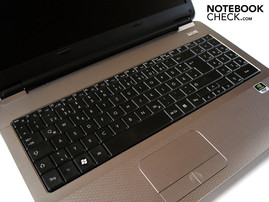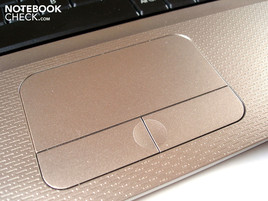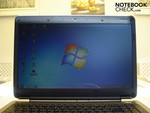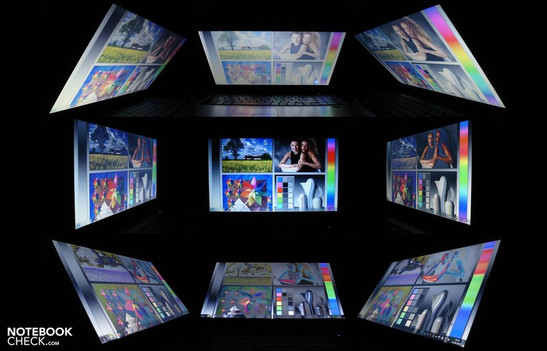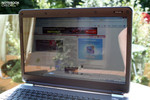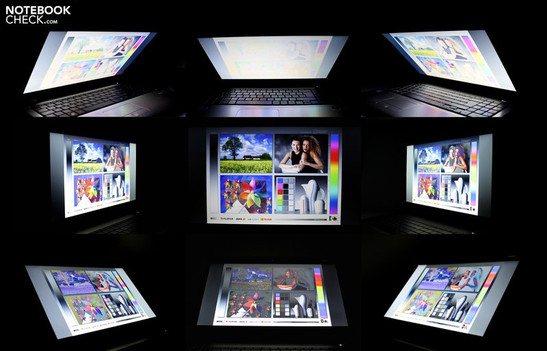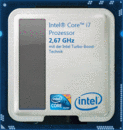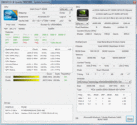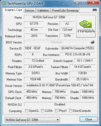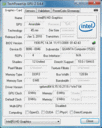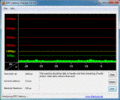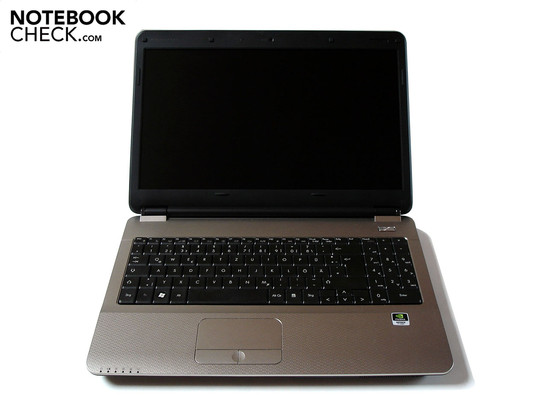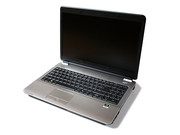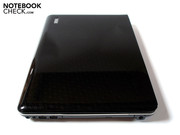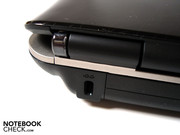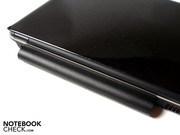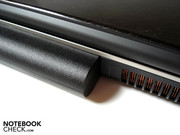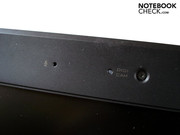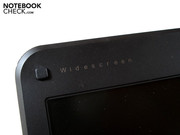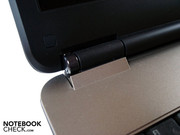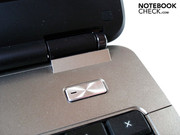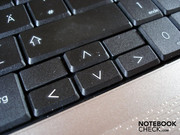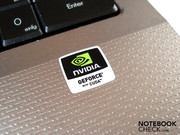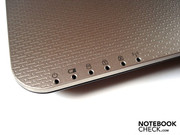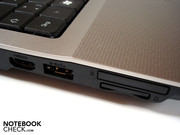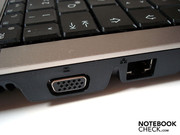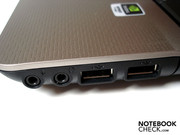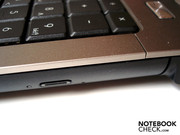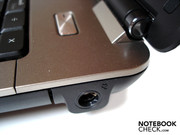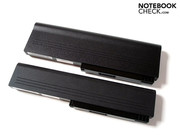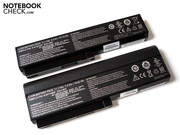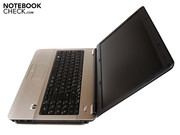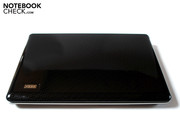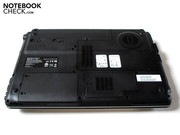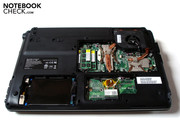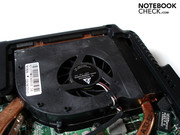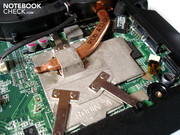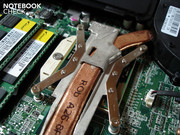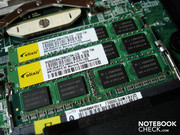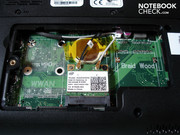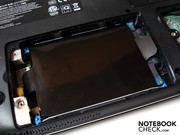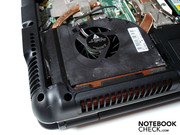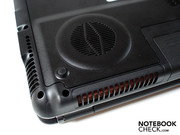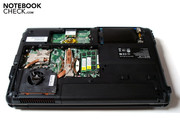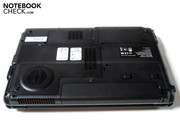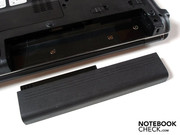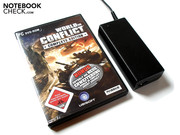Review mySN QMG6 / Chiligreen Mobilitas NW (Quanta TW9) Notebook
The basis of the mySN QMG6 / Chiligreen Mobilitas NW is the TW9 barebone from Quanta, which is also distributed by online shops like Hawkforce or Notebookguru. The Quanta TW9 is a 15.6-inch multimedia-/gaming laptop, which is equipped with processors from Intel's current Core iX range. In order to avoid exhausting the thermal pad, there are only dual-core CPUs; quad-cores are searched for in vain.
As for graphics card there's a mid-range Nvidia GeForce GT 335M. If you go for a matte display, there's also the Optimus technology on board, which can automatically switch between the integrated and dedicated graphics units and thus provides a balance between performance and energy consumption. The DDR3 RAM meanwhile ranges from two to eight GBytes, whilst HDDs, SDDs or brand new hybrid models can be used as hard disks.
Wlan and Bluetooth are – depending on the vendor - integrated as standard or cost extra. In addition the basic equipment includes a DVD burner, yet subject to surcharge a Blu-Ray player or Blu-Ray burner is available. To conclude with the operating system there's the agonising choice between different versions of Windows 7.
Case
Visually, we consider the Quanta TW9 to be thoroughly successful. The upper side is made of a matte-silver plastic and inspires a relatively high-quality impression. Furthermore, the wrist rest is furnished with a fancy texture made of fine stripes and points. On the black display lid Quanta has, however (unfortunately) chosen a high-gloss finish, which not only gets dirty very quickly, but also is immensely susceptible to environmental influences. All the same, thin white lines provide nice accents.
As far as stability is concerned - and not unusual for most laptops - the display lid gives grounds for criticism. This can be noticeably bent and above all the middle can be depressed clearly. Image distortions can be partially provoked. The upper side turns out fundamentally better in this respect. Only under stronger pressure do the wrist rest area and the area above the keyboard give way. Meanwhile, the hinges are far too strong. If you open the laptop, the base unit swings strongly too, regardless of whether you're raising the lid with one or two hands. The maximum opening angle is normal at around 130°.
Regarding dimensions, the Quanta TW9 is moderate, at 373 x 257 x 41 mm (width x depth x height), and at a weight of around 2.6 kg the laptop can still be transported comfortably. Finally we come to workmanship, which is mainly relatively good, yet in detail faults are revealed. Thus on our test device the transition between display borders and display lid was partly made imperfectly; there were rough, distant edges.
Connectivity
Range of Connections
The good connectivity leaves no wishes unfulfilled. External monitors can be connected via HDMI and VGA. HDMI stands out not only because of its very high image quality, but also because of its ability to also transfer sound. Two USB 2.0 ports (right) and an eSATA/USB 2.0 combo (left) offer among other things connection possibilities for hard disks and input devices. In the 34mm Express Card slot the possibility for upgrade cards awaits. In this way the laptop can, for example, be retrofitted with USB 3.0. Internet access is made possible via Gigabit-Lan, Bluetooth and Wlan. Other connectivity features include a 7-in-1 card reader, two sound jacks (1x in & 1x out) as well as a Kensington Lock. A 1.3 Megapixel webcam and an integrated microphone round off the package.
Personally, the positioning of connections didn't please the tester quite as much. As most connection possibilities are to be found so close to the front, the amount of space at the side suffers considerably when many devices are connected due to the mass of cables.
Software and Accessories
MySN is one of the few manufacturers to restrain itself when it comes to software installation. Apart from the necessary drivers the system is very clean; mySN and Chiligreen have both done without bloatware. Customers of an operating system also receive an original Windows 7 disc, which makes an eventual re-installation immensely comfortable. Another advantage: the annoying and time-consuming burning of recovery DVDs by the user aren't necessary. Alongside a driver DVD there are otherwise no further additions in the box - rather scarce. Chiligreen includes Cyberlink's DVD Suite 7 on DVD alongside a driver CD and a recovery disk.
Input Devices
Keyboard
In the review the keyboard leaves behind a tolerable impression. The keys are indeed not free-standing and the pressure point of the respective stroke isn't clear enough, yet the pleasant matte surfaces and the (apart from the arrow keys) fully-dimensioned size are pleasing. The layout is well thought out and to a great extent corresponds to the standard layout, and one gets used to it quickly. Likewise, the manufacturer has accommodated a number pad, despite the limited amount of space on offer.
As for stability, the keyboard is OK. During 'normal' use only a slight amount of give is noticeable on the entire keyboard surface. Only under unusually high pressure can the area around the number pad (to the height of the optical drive) particularly be depressed. The level of noise when typing seemed rather high; in addition the trigger noise is relatively rickety.
Touchpad
There's less to fault when it comes to the touchpad. Through the partly slick surface a neat gliding capability can be observed. Furthermore, the touchpad differentiates itself very well from the textured wrist rest areas; a waypoint is guaranteed for orientation. Horizontally the touchpad is very ample at 9 cm, in comparison, vertically (4 cm) we could have done with a few more millimetres. The touchpad shows no weakness in precision, horizontal and vertical scroll functions are no trouble after a little training
A further plus-point is the support of numerous mouse gestures (scrolling, zooming and twisting). Unfortunately the mouse gestures are relatively delicate and not quite lag-free. Above all we couldn't really get on with the touchy zoom function. Finally, both touchpad keys demand a really high force and work not exactly quietly.
Display
Quanta equips the TW9 with a 15.6-inch display that is in the nowadays established 16:9 format and has a resolution of 1366 x 768 pixels. For games and films such a resolution may be sufficient, yet for (sensible) work it is only partly suitable. With two windows opened next to each other the user will, for example, need to do a lot of scrolling work.
As for display surface the customer has the choice between an anti-glare variant and one without an anti-glare coating. We had both panel types in the review. The disadvantages of a matte display are comparatively faint colours as well as weak contrast levels. The black value has even bigger effects than on a high-gloss display, as the image seems greyish more quickly in dark passages. Instead matte displays score points with a better capability for outdoor use. Thus when outdoors there are rarely disturbing reflections, which hinder high-gloss displays indoors on a daily basis.
Measurement AUO23EC panel (matte)
| |||||||||||||||||||||||||
Brightness Distribution: 74 %
Contrast: 201:1 (Black: 1.01 cd/m²)
The built-in panel settles in the mid range in terms of performance. An average brightness of 192.3 cd/m² is acceptable, yet a bit more intensity in games or films wouldn't have hurt. The illumination is somewhat worse than the competition at 74%, yet in practice the user will rarely realise the difference between 163.9 cd/m² in the darkest area and 221 cd/m² in the brightest. The black value is average at 1.01 cd/m²; for crisp blacks the value must be under 0.4 cd/m². Unfortunately, as has been the case more and more often recently, the contrast ratio is really disappointing at 201:1.
Reasonable viewing angle stability is additionally lacking. Small deviations in viewing angle are even enough to distort colours and illumination. If several people sit in front of the device it's almost impossible to bestow upon each an optimal image.
Measurement CPT14BF panel (glare)
| |||||||||||||||||||||||||
Brightness Distribution: 82 %
Center on Battery: 235 cd/m²
Contrast: 170:1 (Black: 1.38 cd/m²)
As mentioned already, we could also test the alternative glossy variant in the Quanta TW9. The results show an overall higher brightness of the display at an average of 213 cd/m². That's an increase of around 10%. Also the illumination turns out better than the matte variant at 82%.
Surprise: the contrast. With a black value of 1.38 cd/m² and a maximum contrast ratio of 170:1 the glare-type panel turns out worse than its matte equivalent. Another sign against the further indication against the prevalent assumption: reflective displays would sweepingly have a better contrast than matte displays.
In the open the panel gleams only in the direct sense of the word. The reflections make working on the laptop tiresome. The brightness would suffice, at least to be able to see enough on the screen in the shade.
The viewing angle stability turns out very unassumingly, just like the matte variant. In the vertical spectrum slight deviates from the ideal viewing angle are enough to provoke strong colour changes. Horizontally the image stays stable for longer, yet you still have to cope with reflections appearing indoors.
Performance
According to configuration, a dual-core from Intel's current Core i3, i5 or i7 range come into play as processors. MySN as well as Chiligreen have equipped our test devices with the (for the time being) fastest dual-core Core i7-620M. This has a standard clock speed of 2.66 GHz. Via the so-called Turbo Boost technology the clock speed of individual cores can be raised on demand automatically, up to 3.33 GHz. Hyperthreading in turn provides the simulation of two addition CPU cores, so that the Core i7-620M can work with up to four threads simultaneously. In most games hyperthreading brings no advantages, yet adapted applications can in contrast greatly profit from the technology.
Furthermore, the Core i7-620M has an integrated, yet comparatively weak graphics chip called GMA HD. 512 KByte L2- as well as four MByte L3 cache and a maximum temperature of 105°C are further features of the processor manufactured to the 32nm process (GMA HD: 45nm). Indeed the energy consumption is rather high at 35 Watt, yet in view of the offered performance it's still reasonable.
In order to fulfill the title of a gaming laptop, Quanta has fitted the TW9 with a GeForce GT 335M from Nvidia. The mid-range graphics card is made in the 20nm process and has 72 unified shaders (GTS 360M: 96 shaders) as well as 1024 MBytes of memory. The clock speeds correspond to Nvidia's specifications with 450 MHz (core), 790 MHz (memory) and 1080 MHz (shader). The biggest problem of the GeForce GT 335M is its small memory connection: nowadays 128 bit simply isn't appropriate, especially when it draws on DDR3-VRAM, like it is the case with the GeForce GT 335M. Further flaw: there's no DirectX 11 support; the user has to make do with DirectX 10.1.
Nvidia Optimus
An absolute highlight of the Quanta TW9, meanwhile, is Nvidia's exclusive Optimus technology. If a laptop has not only an integrated but also a dedicated graphics card, Optimus can dynamically switch between the graphics units (depending on current demand profile). For example, if you're just surfing the internet, only the GMA HD is active. As soon as you start a game, the graphics computations are taken over by the GeForce GT 335M. This switching is carried out fully automatically and takes place as fast as lightning and without any visible transition.
So basically there are great premises, whilst there are a few problems that we could notice on our test systems.
On our test systems there was the antiquated graphics driver version 189.47 (also provided on the CD), which, during the test, was partly to blame for the problems. No matter what we adjusted in the driver on the QMG6, Battery Eater, Cinebench and Metro 2033 didn't work in cooperation with the GeForce GT 335M. In addition we couldn't run the 3DMark Vantage benchmarks for Need for Speed Shift (Demo) or Risen (Demo), as these constantly crashed with error messages concerning PhysX. Also, the subsequent installation of the PhysX package caused no improvement, as observed on the mySN QMG6.
The identically constructed Chiligreen had the same pre-installed graphics drivers (189.47). Also we couldn't get Cinebench R10 or the R11.5 OpenGL test to run with the GT 335M. Interesting nonetheless: PhysX error messages, for example on 3DMark Vantage, NFS Shift or Risen, were absent, whereby the software image on the QMG6 could present a possible source of error and the OpenGL problem might be down to the aged driver.
But that's not all: the GeForce GT 335M was from time to time no longer available, probably due to a faulty bios on the QMG6. This made itself known because suddenly the Nvidia symbol in the info area of the taskbar disappeared and also the graphics driver was no longer selectable. In the device manager the graphics card wasn't even there. The problem arose occasionally during usage and could only be corrected by numerous restarts. On the Chiligreen Mobilitas NW such a problem wasn't observed. After a bios update this problem was finally got to grips with on the QMG6.
Altogether, on our test devices, several different problems came together. It's probably not insignificant that we had one of the first supplied samples for the review.
Here there might not be an entirely flawless image on the QMG6, which was responsible for various error messages concerning PhysX, and the same could not be noticed on the Chiligreen, of identical construction. Also the problem with the disappearing GT 335M graphics card only appearing on the QMG6 could admittedly be removed with a bios update. In the meantime a current bios version should be installed for all when purchasing certain devices.
Finally there were still problems with the compatibility of the Optimus driver with current games, along with OpenGL in Cinebench shading test and in the Batteryeater Classic test. Here only the wait for a current, compatible version of the driver helps, which will hopefully be released directly by Nvidia. According to the current update rhythm you could expect new drivers in September.
CPU Performance
So now let's turn to the application benchmarks. We started with the processor-heavy Cinebench R10 (64bit), in which there was already a great surprised. Thus the Core i7-620M of the QMG6, with 3545 to 4295 points (single-core rendering) lines up far behind the Core i7-620M of the very similarly equipped Asus N82JV. It was the same picture in multi-core rendering: here the Asus N82JV (8962 points) overtook the mySN QMG6 (7721 points) by around 16% despite the identical processors.
| PCMark Vantage Result | 6102 points | |
Help | ||
GPU Performance
In the graphics benchmarks the GeForce GT 335M had to take on its main competition from ATI, the extremely popular mid-range model, the Mobility Radeon HD 5650. For the purposes of comparison we consulted the 15.6-inch Acer TravelMate 5740G. In 3DMark 03 performance differences become clear. Whilst the GeForce GT 335M enters the books with a good 16922 points, the Radeon HD 5650 computes around 25% more quickly with 21115 points. In 3DMark 05 the difference diminishes noticeably and both graphics cards get almost the same results with 13339 points (GT 335M) and 13564 points (HD 5650). In 3DMark 06, however, the tables are turned and the GeForce GT 335M, with 6950 points, can position itself around 4% in front of the Radeon HD 5650 (6715 points).
| 3DMark 03 Standard | 16922 points | |
| 3DMark 05 Standard | 13339 points | |
| 3DMark 06 Standard Score | 6950 points | |
Help | ||
HDD Performance
As you can also configure the mySM QMG6 with brand new hybrid hard disks from Seagate, we of course couldn't let the opportunity to test these go. Hybrid hard disks unite the advantages of HDDs (more memory) and SSDs (high performance). Thus hybrid models, alongside the conventional HDD, have a small flash memory unit, which on the built-in Seagate Momentus XT ST95005620AS (500 GByte,s 7200 RPM) has four GBytes of memory.
At least the values with HDTune turned out to be sobering. The average transfer rate of the hybrid hard disk, at 84.6 to 80.5 MB/Sec only slightly above that of a Seagate ST9500420AS (500 GBytes, 7200 RPM, e.g. im mySN MG7.c), which has no such flash memory. The access time is almost identical at 17.1 to 17.3 ms.
The AS SSD benchmark, as well as the CrystalDiskMark, reveals a different picture. Here the hybrid hard disk can in parts clearly contrast from classical HDDs.
Performance Verdict
The application performance of the mySN QMG6 can be described as very good. Intel's Core i7-620M is an immensely strong dual-core CPU, which makes itself suited for each purpose with its high clock speed and thanks to modern features like hyper-threading. Regarding the graphics performance it admittedly seems rather oversized; a Core i5 processor is completely sufficient for most users.
Anno 1404
At the native resolution of 1366 x 768, high details and 2x AF the city-building strategy game runs pleasantly fluidly at 37.3 fps. Very high details and 4x AF should not be expected of the GeForce GT 335M, with 24.8 fps at a resolution of 1280 x 1024 there were constant judders.
| Anno 1404 | |||
| Resolution | Settings | Value | |
| 1280x1024 | very high, 0AA, 4AF | 24.8 fps | |
F.E.A.R. 2
Fear 2 has been available for a while now and causes no kind of problems for the GeForce GT 335M, even at more demanding settings. At the resolution of 1280 x 1024, high details and 4x AA we reached a good average rate of 39.4 fps.
| F.E.A.R. 2 | |||
| Resolution | Settings | Value | |
| 1280x1024 | high, all on, 4xAA, biliniarAF | 39.4 fps | |
| 1024x768 | medium, all on, 2xAA, biliniarAF | 63.6 fps | |
Modern Warfare 2
At 33.2 fps Modern Warfare 2 is basically acceptably playable in the resolution 1366 x 768, high details and 4x AA. Unfortunately the performance well and truly collapses in very resource-heavy scenes (e.g. with strong smoke). At medium details and 2x AA (1024 x 1024) temporary judders indeed aren't absent, yet overall the performance noticeably increases to 39.4 fps.
| CoD Modern Warfare 2 | |||
| Resolution | Settings | Value | |
| 1366x768 | all on/high vsync off, high textures, 4xAA | 33.2 fps | |
| 1024x768 | all on/med vsync off, normal textures, 2xAA | 39.4 fps | |
Bad Company 2
In the newest Battlefield offshoot you basically have to make do with medium details; high details and 4x AF (1366 x 768) judder at 24.4 fps, which is unplayable. If you bring the details down to the middle and do without quality improvements, the performance levels off at 34.9 fps at a resolution of 1366 x 768.
| Battlefield: Bad Company 2 | |||
| Resolution | Settings | Value | |
| 1366x768 | high, HBAO on, 1xAA, 4xAF | 24.4 fps | |
| 1366x768 | medium, HBAO off, 1xAA, 1xAF | 34.9 fps | |
Dirt 2
As the GeForce GT 335M doesn't support DirectX 11 effects, Dirt 2 performs somewhat better on comparable ATI graphics cards. At a resolution of 1366 x 768, high details and 2x AF it allows you to bomb down the rally routes at 30.2 fps, which is still fairly fluid.
| Colin McRae: DIRT 2 | |||
| Resolution | Settings | Value | |
| 1360x768 | High Preset, 2xAA | 30.2 fps | |
| 1024x768 | Medium Preset, 0xAA | 46.8 fps | |
Crysis
The classic shooter Crysis enchants with its grandiose visuals, yet the extreme hardware demands really make notebook graphics cards sweat. Thus high details, even at a relatively low resolution like 1024 x 768 don't run nearly fluidly enough (24.9 fps). Decreasing to medium details improves the fps noticeably; at a resolution of 1024 x 768 it's enough to reach 43.4 fps.
| Crysis - GPU Benchmark | |||
| Resolution | Settings | Value | |
| 1024x768 | High | 24.9 fps | |
| 1024x768 | Medium, 0xAA, 0xAF | 43.4 fps | |
Verdict - Gaming Performance
The gaming performance of the mySN QMG6 is thoroughly impressive. The GeForce GT 335M is, at the native resolution of 1366 x 768, capable of running most current titles with middle to high details fluidly. The GeForce GT 335M can't quite hold its own against the successful Radeon HD 5650, really it reaches the performance level of a Radeon HD 4670.
| low | med. | high | ultra | |
|---|---|---|---|---|
| Crysis - GPU Benchmark (2007) | 43.4 | 24.9 | ||
| Crysis - CPU Benchmark (2007) | 42.6 | 22.3 | ||
| F.E.A.R. 2 (2009) | 63.6 | 39.4 | ||
| Anno 1404 (2009) | 24.8 | |||
| Colin McRae: DIRT 2 (2009) | 46.8 | 30.2 | ||
| CoD Modern Warfare 2 (2009) | 39.4 | 33.2 | ||
| Battlefield: Bad Company 2 (2010) | 34.9 | 24.4 |
Emissions
System Noise
As long as the integrated graphics unit is active, the Quanta TW9 remains relatively quiet. Under light load (office, internet) the case fan runs really gently and is only slightly noticeable. If you put on a DVD, the optical drive indeed becomes noticeable for a few seconds, yet it soon sinks back down to a modest sound level. Therefore you can fully concentrate on the quieter film scenes. If you turn the dedicated graphics card on (3D applications, games), the quiet is however quickly abandoned and the fan becomes clearly audible. Even if you adjust the loudspeakers to maximum volume, the sound of a game is drowned out by the constantly present fan noise.
Noise level
| Idle |
| 31.7 / 32 / 36.2 dB(A) |
| HDD |
| 32 dB(A) |
| DVD |
| 35.4 / dB(A) |
| Load |
| 45.2 / 45.2 dB(A) |
 | ||
30 dB silent 40 dB(A) audible 50 dB(A) loud |
||
min: | ||
Temperature
As for the development of heat, above all the underside of the case has to accept criticism. Even when idle it is anything but cool at a maximum of 37.9°C. Under load even up to 45.6°C is reached, thus on the lap it can become unpleasant after some time. The upper side doesn't become quite so warm, at up to 31.7°C when idle and 38.2°C under load. The wrist rest area meanwhile lingers in the pleasant regions with a maximum of 29.9°C even under load.
(+) The maximum temperature on the upper side is 38.2 °C / 101 F, compared to the average of 36.9 °C / 98 F, ranging from 21.1 to 71 °C for the class Multimedia.
(-) The bottom heats up to a maximum of 45.6 °C / 114 F, compared to the average of 39.2 °C / 103 F
(+) In idle usage, the average temperature for the upper side is 30.6 °C / 87 F, compared to the device average of 31.3 °C / 88 F.
(+) The palmrests and touchpad are cooler than skin temperature with a maximum of 29.9 °C / 85.8 F and are therefore cool to the touch.
(±) The average temperature of the palmrest area of similar devices was 28.7 °C / 83.7 F (-1.2 °C / -2.1 F).
Loudspeakers
The TW9 has two loudspeakers, which Quanta has positioned in the front area of the underside. Aside from the limited maximum volume, the offered sound proves to be immensely poor. Bass isn't distinguishable, whilst all tone regions seem dull, thin and tinny. For this reason games and films clearly lose their atmospheres, whilst music loses its vitality. In short: the integrated loudspeakers impair the multimedia enjoyment greatly; the use of external loudspeakers should in no case be done without.
Battery Life
Two different batteries are available for the Quanta TW9. In the basic equipment there is a six-cell battery with a reasonable 57.72 Wh. Optionally there is also a nine-cell battery, which is fundamentally strong with 79.92 Wh. MySN has kindly made both variants available to us.
Via the Optimus technology even the battery life of the six-cell model is convincing. For DVD playback with maximum brightness and moderate energy-saving options the laptop lasts for exactly 2 hours and 30 minutes, so the majority of films can be completely played back. If you want to surf the internet via WLAN you can on the other hand reckon with three hours and 15 minutes. In optimal conditions in the form of low load (Readers Test from Battery Eater), minimum brightness and maximum energy-saving mechanisms, the six-cell battery ran out of steam after just under 4.5 hours.
With the 9-cell battery the battery life increases considerably. Now 4 hours and 10 minutes of DVD playback is possible, which is an improvement of 67%. The battery life whilst WLAN surfing increased by 70% to 5 hours and 32 minutes. In the Readers Test from Battery Eater the laptop finally had to be plugged in after 7 hours and 42 minutes, which is also 70% more than with the 6-cell model. If you put a lot of value on the possible battery life, you should consider the surcharge of around 100 Euro for the 9-cell model.
The energy consumption strongly depends on which graphics card is currently active. With GMA HD the Quanta TW9 requires between 16.1 – 21.8 Watt when idle and 43.6 – 65.7 Watt under load – each time acceptable values. The additional consumption of the GeForce GT 335M is 18.7 – 30.9 Watt when idle and 64.0 – 94.7 Watt under load at around 40% more. With 94.7 Watt under full load the supplied 90 Watt power supply is pushed to its limits. If you use a different processor the battery life and energy consumption can of course vary.
| Off / Standby | |
| Idle | |
| Load |
|
Key:
min: | |
Verdict
Overall, Quanta has succeeded in making a sound multimedia/gaming laptop with the TW9. Intel's Core iX processors, along with the Nvidia GeForce GT 335M provide good application- and gaming-performance, which should more than satisfy the average user. As for emissions the verdict turns out conflictingly: whilst the temperature- and sound-development when idle is still acceptable, the laptop proves to be relatively loud and warm under load. The sound quality of both integrated loudspeakers, by comparison, is disappointing across the board.
Another drawback is the poor display, which - like most current laptops - gets by with a low contrast, a high black value and extremely limited viewing angles. The fact that you can also configure the display as an anti-glare variant is praiseworthy, which is rarely seen amongst the competition. The actual star of the Quanta TW9 is admittedly Nvidia's Optimus technology, which doesn't just actively help with energy saving, but also guarantees good battery life.
However, the Optimus technology then only works without a hitch when you've got the current drivers. Unfortunately Quanta fluffs up in this respect and supplies the TW9 with an antiquated GPU driver and a partly incomplete bios. In our test device this led to numerous bugs, error messages and incompatibilities, which negatively shaped the review.
It can just be hoped that after our test devices, coming from the first batch of the laptops, will receive an update bios and driver, in order to give customers a laptop which can be used in the future without problems.







